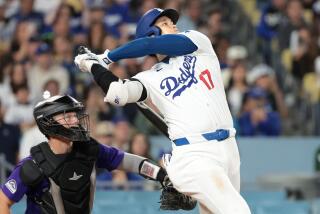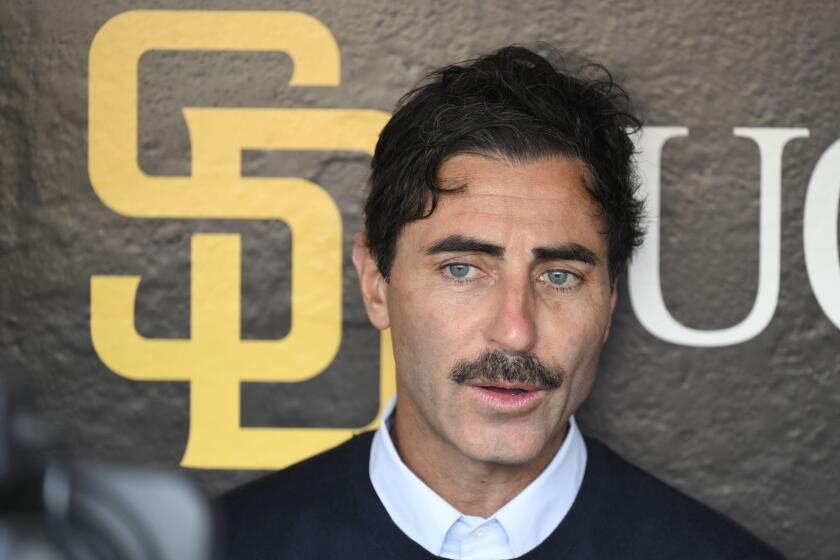Who’s getting taken for a ride here?
The Dodgers open their home season Tuesday, and there’s a new wrinkle. You don’t have to drive.
There is now a Dodger Stadium Express, a bus back and forth from Union Station. Lots of train links from there. No sitting in traffic. No choking on smog.
This is a good thing.
FOR THE RECORD:
Dodger Stadium Express: Bill Dwyre, in his column in Saturday’s Sports section about the Dodgers’ revived bus transportation to and from Union Station on game days, said there was a Metrolink stop at Staples Center. The stop is actually for the Blue Line light-rail train, which is run by the MTA. —
Howard Sunkin, senior vice president of the McCourt Group, whose boss is Dodgers owner Frank McCourt, says that Dodger Stadium was the only major league baseball stadium without public transportation. He says he remembers fondly riding the bus to Dodger Stadium when he was a youngster.
Along the way, that busing stopped, started again, then stopped last year. No public financing was available. Then, this year, $300,000 was found and now, an estimated 2,500 people per game will ride the buses to and from Dodger Stadium, free of charge.
This is also a good thing.
The $300,000, chump change in the overall picture of public funding, was given to the Metropolitan Transportation Authority, which provides the buses. The $300,000 came from something called the MSRC, short for Mobile Source Air Pollution Reduction Review Committee. MSRC is an arm of the AQMD, the South Coast Air Quality Management District. If you have a business in a building and you emit bad stuff into the air, the AQMD is after you. If you do it in a car, or something mobile, the MSRC is your enemy.
In summary, the MTA got money from the MSRC. Government has acronyms for its acronyms — perhaps so that taxpayers will never attempt to penetrate the maze that would reveal where their money goes?
This is a bad thing.
The MSRC got the $300,000 from Sacramento, which got it from you, Joe Taxpayer. That is, assuming you own a car. When you wrote that check for your license plate to the DMV, $4 of that was put in a fund into which MSRC can dip for programs to make our air less polluted. MSRC doles out millions to this end, mostly to other public entities for such things as cleaner-running school buses and alternate fueling stations that use compressed natural gas. Or, in government-speak, CNGs.
The MSRC also funds some pollution improvement for private companies. A list of 130 such companies was provided to The Times by the MSRC’s public relations agency. These for-profit companies acquire funding by writing proposals. According to Michael Cano, transportation deputy for L.A. County Supervisor Mike Antonovich, who championed the busing plan, the Dodgers did not write a proposal.
The list accounts for activity from 2002 through the present and totals $55 million in expenditures. That means the Dodgers are not the only company making a buck for themselves and getting help doing it from tax money. Even so, no less than the chairman of the MTA, Ara Najarian, understands that there have been some eyebrows raised over this.
“We’re a nonprofit,” Najarian says, “and [Frank McCourt’s] a for-profit.”
Sunkin has said that the Dodgers will do a sort of matching “in kind” of the public $300,000. That will consist of website exposure, plus radio and TV airtime, reminding people of the buses. Charley Steiner can say, in the game broadcast: “… And that is the third time tonight that Manny has fanned on the sinker, and remember, fans, take the bus to the stadium.”
Sunkin also correctly points out that there is public transit to just about every other sports facility in Southern California. There are buses that stop at Pauley Pavilion, a Metrolink stop at Staples Center, a train station near Angel Stadium. What he probably forgot was that the people busing to Pauley or taking trains to Staples or Anaheim are paying for it. As a matter of fact, they are also paying, from their tax money, for the people who are busing to Dodger Stadium for free.
This is not such a good thing.
Sunkin also points out, correctly again, that the Dodgers lose out on lots of parking revenue, at $15 a car, when people use the bus.
Let’s crunch some numbers: If those 2,500 bus-users represent 1,250 car-parkers, at $15 each, the Dodgers have taken a revenue loss of $18,750 a game or $1,518,750 for the 81-game home season. But also, if 1,000 of the bus-users have been enticed to go to the game and buy a ticket because of ease of transportation, and they pay $25 a ticket, that’s a revenue gain of $25,000 a game, or $2,025,000 a season. Speculative numbers, of course.
Let’s tally up. The air will be better. Traffic will be improved. There will be less stress just getting to the game. The Dodgers won’t lose any money and will probably make more.
And we, the taxpayers of California, get to help out the McCourts.
This is a good thing. Or is it?
More to Read
Are you a true-blue fan?
Get our Dodgers Dugout newsletter for insights, news and much more.
You may occasionally receive promotional content from the Los Angeles Times.








